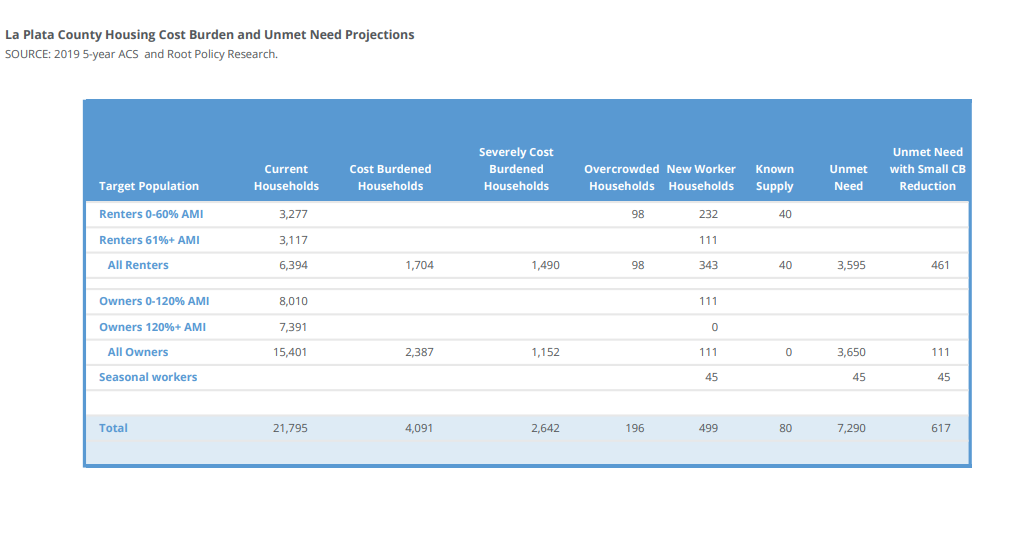What do we mean by housing accessibility and affordability?
What values and goals should our community focus on as we work to address the current housing crisis? November 15 we hosted our first Community by Conversation event at Fort Lewis College with the goal of identifying key community concerns and coming up with underlying values. You can check out the results of our discussion below:
| cxc_housing_responses.pdf | |
| File Size: | 2755 kb |
| File Type: | |
Housing trends in Durango
Cost burdened households pay 30 percent or more of their gross household income in housing costs, which is above the industry standard for renting or home buying. Those who pay more than 50 percent are “severely” cost burdened. The higher the cost burden, the greater the risk of eviction or foreclosure.
La Plata County has seen a 20 percent increase in renters that are cost burdened since 2010.
Wages in La Plata County increased by 5 percent between 2010 and 2019 while rents increased by 22 percent (more than four times wage increases).
Over the last decade, La Plata County has seen a decline in families with children, and an increase in senior adults moving to the area.
La Plata County has seen a 20 percent increase in renters that are cost burdened since 2010.
Wages in La Plata County increased by 5 percent between 2010 and 2019 while rents increased by 22 percent (more than four times wage increases).
Over the last decade, La Plata County has seen a decline in families with children, and an increase in senior adults moving to the area.
Housing price increases:
The second quarter median price for an in-town Durango home hit $650,000, a 30.3% increase from the median price of $499,000 for the same quarter in 2020... In the Durango Mountain area, the second quarter median price for a single-family home came in at $1.16 million, up 43.2% from the $810,000 median price for the second quarter of 2020.
- The Durango Herald
Needs for additional units are significant in the “missing middle” demographic, or those earning 80% to 120% of the area median income.
28 percent of La Plata County’s workforce lives outside of the county and commutes in.
Between 2010 and 2019, none of the five counties in the region, including La Plata County, were able to meet demand for housing to accommodate employment growth and the need for seasonal and vacation housing; the city of Durango has one month of housing inventory compared to their six months of inventory goal.
Based on an analysis of long term housing needs and forecasts from the Colorado State Demographer, the five-county region needs to increase annual residential development to about 900 units per year. This is sobering given that the region averaged just 130 units per year between 2010 and 2019.
A significant amount of the region’s forecasted demand falls in La Plata County. The Root Policy authors project that the county will need 570 new permanent units and 45 seasonal surge beds in the next 3-5 years to accommodate workforce growth and address some of the county’s unmet housing needs.
SOURCE: 2019 5-year ACS and Root Policy Research
28 percent of La Plata County’s workforce lives outside of the county and commutes in.
Between 2010 and 2019, none of the five counties in the region, including La Plata County, were able to meet demand for housing to accommodate employment growth and the need for seasonal and vacation housing; the city of Durango has one month of housing inventory compared to their six months of inventory goal.
Based on an analysis of long term housing needs and forecasts from the Colorado State Demographer, the five-county region needs to increase annual residential development to about 900 units per year. This is sobering given that the region averaged just 130 units per year between 2010 and 2019.
A significant amount of the region’s forecasted demand falls in La Plata County. The Root Policy authors project that the county will need 570 new permanent units and 45 seasonal surge beds in the next 3-5 years to accommodate workforce growth and address some of the county’s unmet housing needs.
SOURCE: 2019 5-year ACS and Root Policy Research




